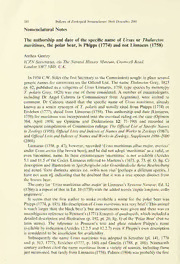
The Authorship And Date Of The Specific Name Of Ursus Or Thalarctos Maritimus, The Polar Bear, Is Phipps (1774) And Not Linnaeus (1758) PDF
Preview The Authorship And Date Of The Specific Name Of Ursus Or Thalarctos Maritimus, The Polar Bear, Is Phipps (1774) And Not Linnaeus (1758)
310 Bulletin ofZoological Nomenclature 58(4) December 2001 Nomenclatural Notes The authorship and date of the specific name of Ursus or Thalarctos maritimus, the polar bear, is Phipps (1774) and not Linnaeus (1758) Anthea Gentry ICZN Secretariat, clo The Natural History Museum, Cromwell Road, London SW7 5BD, U.K. In 1934 C.W. Stiles (the first Secretary to the Commission) sought to place several generic names for carnivores on the Official List. The name Thalarctos Gray, 1825 (p. 62, published as a subgenus of Ursus Linnaeus, 1758, type species by monotypy T polaris Gray, 1825) was one of those considered. A number of mammalogists, including Dr Angel Cabrera (a Commissioner from Argentina), were invited to comment. Dr Cabrera stated that the specific name of Ursus maritimus, already known as a senior synonym of T. polaris and usually cited from Phipps (1774) or Erxleben {Mil), dated from Linnaeus (1758). This authorship and date (Linnaeus, 1758) for maritimus was incorporated into the eventual ruling on the case (Opinion 384, April 1956; see Opinions and Declarations 12: 71-190) and recorded in subsequent compilations ofCommission rulings: The OfficialList ofSpecific Names in Zoology (1958), OfficialLists andIndexes ofNames and Works in Zoology (1987), and OfficialListsandIndexesofNamesand Works inZoology, Supplement 1986-2000 (2001). Linnaeus (1758, p. 47), however, recorded 'Ursus maritimus albus major, arcticus' under Ursus arctos (the brown bear), and he did not adopt 'maritimus' as a valid, or even binominal, name. In these circumstances 'maritimus' is not available (Articles 5.1 and 11.5 ofthe Code). Linnaeus referred to Martens's (1675, p. 73, pi. O, fig. C) description and illustration in Spitzbergische oder Groenlandische Reise Beschreibung and noted 'forte distincta species est, nobis non visa' [perhaps a different species, I have not seen it], indicating that he doubted that it was a true species distinct from the brown bear. Theentryfor 'Ursusmaritimusalbusmajor' in Linnaeus's SysternaNaturae, Ed. 12 (1766) is a repeat ofthat in Ed. 10 (1758) with the added words 'capite longiore, collo angustiore'. It seems that the first author to make available a name for the polar bear was Phipps (1774, p. 185). Hisdescriptionof Ursusmaritimuswasvery brief('This animal is much larger than the black bear'), but measurements were given and there was an unambiguous reference to Pennant's (1771) Synopsisofquadrupeds, which included a detailed description and illustration (p. 192, pi. 20, fig. 1) ofthe 'Polar Bear' (but no latin name). The reference to Pennant's text and plate renders Phipps's name available by indication (Articles 12.2.5 and 12.2.7) even if Phipps's own description is considered to be insufficient for availability. Subsequently the name Ursus maritimus was adopted in Schreber (pi. 141, 1776 and p. 513, 1777), Erxleben (1777, p. 160) and Gmelin (1788, p. 101). Nineteenth century authors cited the name maritimus from a variety ofsources, including those justmentioned, but rarelyfrom Linnaeus (1758). Palmer(1904)wasprobablythefirst 1 Bulletin ofZoological Nomenclature 58(4) December 2001 31 to cite the name from Phipps (1774) and this has been followed by nearly all subsequent authors. It isclearthat attribution ofthenamemaritimusto Linnaeus (1758) in Opinion 384 was an error. Authors both before (see, for example, Ellerman & Morrison-Scott, 1951) and after (for example, Corbet, 1978 and Wilson & Reeder, 1993) the 1956 ruling have cited Phipps (1774) as the author and date of the name; this practice should be continued and the entry on the Official List should be corrected. The name Ursus marinus, independently proposed by Pallas (1776, p. 691), is a junior synonym of Ursus maritimus Phipps, 1774. References Corbet, G.B. 1978 ThemammalsofthePalaearcticRegion: a taxonomicreview. 314pp. British Museum (Natural History), London. Ellerman,J.R.& Morrison-Scott,T.C.S. 1951. ChecklistofPalaearcticmammals1758to 1946. 810 pp. British Museum, London. Erxleben, J.C.P. 1777. Systerna Regni Animalis . . . Classis 1, Mammalia, xlviii, 636, [64] pp. Lipsiae. Gmelin, J.F. 1788. Caroli a Linne, Systema Naturae, Ed. 13, vol. 1, part 1 (Mammalia), xii, 232 pp. Lipsiae. Gray, J.E. 1825. On the genus Ursus ofCuvier, with its divisions into subgenera. Annals of Philosophy, (N.S.)IO: 59-62. Linnaeus, C. 1758. Systema Naturae, Ed. 10, vol. 1. 824 pp. Salvii, Holmiae. Linnaeus, C. 1766. Systema Naturae, Ed. 12, part 1. 530 pp. Salvii, Holmiae. Martens, F. 1675. Spitzbergische oder Groenlandische Reise Beschreibung . . . 1671. [6], 232, 3 pp., [14] pis. Hamburg. Pallas, P.S. 1776. Reise durch verschiedene Provinzen des Russischen Reichs, vol. 3. [18], 760, 23 pp. St Petersburg. Palmer, T.S. 1904. Index Generum Mammalium: a list ofthegenera andfamilies ofmammals. 984 pp. North American Fauna, No. 23. U.S. Department ofAgriculture, Washington. Pennant, T. 1771. Synopsis ofquadrupeds, xxv, 382 pp. Chester. Phipps, C.J. 1774. A voyage towards the North Pole undertaken . . . 1773. viii, 253 pp., 14 pis. Nourse, London. Schreber,J.C.D. von. 1776, 1777. DieSaugthiere, vol. 3. Pis. 92B, 139-145 (1776), pp. 457-584 (1777). Leipzig. Wilson, D.F. & Reeder, D.M. (Eds.). 1993. Mammal species ofthe world. A taxonomic and geographic reference, Ed. 2. xviii, 1206 pp. Smithsonian Institution Press, Washington. Availability of zoological names published in theses P.K. Tubbs Executive Secretary, International Commission on Zoological Nomenclature The Commission Secretariat is frequently asked about the availability of names (and nomenclatural acts, such as the designation of type species) from their publication in theses, and it may be helpful to state the position. TherehasneverbeenaprovisionintheCodeto theeffectthat anameoractcannot be made available from its appearance in a thesis. It follows that if a thesis is 'published' in the sense of the Code (Articles 8 and 9) names and acts in it will be available if the other necessary conditions are met.
